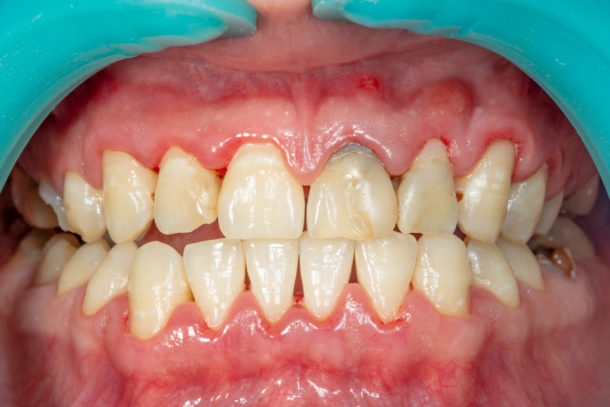As we wrapped up National Dental Hygiene Month in October, it seemed fitting to follow up with information about the different stages of gum disease. As your hygienist has probably discussed with you, we take measurements of your gums at least every 12 months to help us determine what stage of health your gums and bone are at.

This is part of the periodontal assessment which includes: pocket depths, recession, bleeding, mobility, and root furcation involvement. This assessment along with radiographs will help us decide what treatment will be best for you.
Breakdown of Each Stage
Here is a breakdown of each stage of periodontal disease and guidelines that help us categorize which state your oral health is in and how to improve it.
Inflamed bleeding gums are indicative of disease

Healthy Gums:
Healthy gum tissue is pink and firm. We see no bleeding and 2-3mm gum pockets are ideal. All teeth are firmly supported by the surrounding bone and gums.
Gingivitis:
With Gingivitis pockets are slightly deeper, commonly 4mm. Gingivitis is caused by an accumulation of bacteria over time. Gums become visibly swollen and usually bleed easily with brushing and flossing.
At this stage the inflammation is limited to the gum tissue which makes it reversible and we can help to get you into a healthy oral state. If the bacteria are not disrupted and the plaque removed, gingivitis will progress to gum disease.
Once gingivitis has progressed to periodontitis, we use categories to express the severity.
Early Periodontitis:
In early stages we see inflammation in the gums that has progressed into the gums starting to pull away from the teeth. This forms pockets that further trap plaque, bacteria and food leading to the infection in the gums. The bacterial toxins as well as the body’s own immune response will begin the process of bone loss.
Moderate Periodontitis:
In moderate stages the infection worsens. Inflammation becomes more pronounced and bleeding more severe. As bone levels and gum tissue continues to recede you may experience discomfort.
Advanced Periodontitis:
In advanced periodontics gum disease worsens. Pockets will deepen significantly and periodontal abscesses will begin to form. These will cause a foul taste and pain. At this stage, enough bone is lost that teeth become mobile and have a poor prognosis.
References:
American Academy of Periodontology:
https://www.perio.org/consumer/types-gum-disease.html
Colgate:
https://www.colgateprofessional.com.au/education/patient-education/topics/plaque-and-gingivitis/stages-of-gum-disease
Marlborough Associates:
https://www.marlboroughdentistry.com/patient-info/stages-periodontal-disease/


